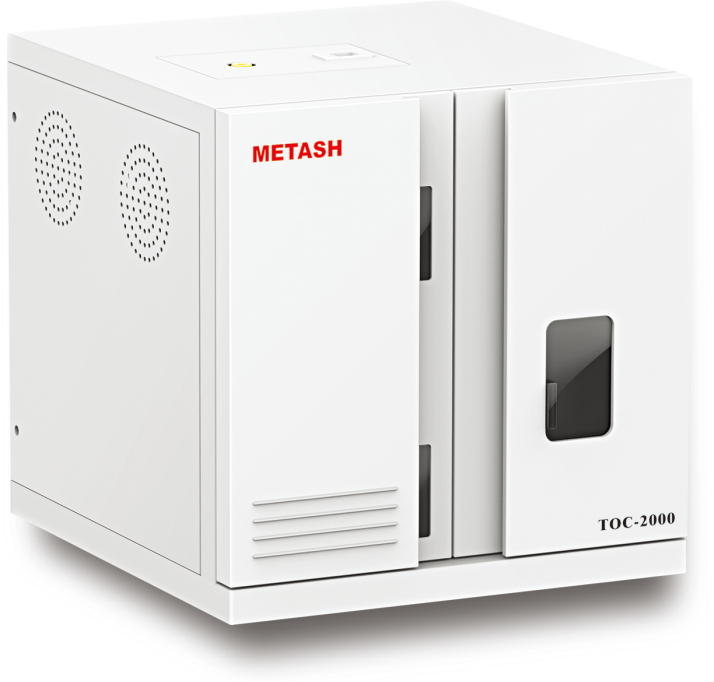With the rapid development of industry, the types and quantities of waste water have increased rapidly, and the pollution of water bodies has become increasingly widespread and serious, threatening human health and safety. Therefore, for the protection of the environment, the treatment of industrial wastewater is more important than the treatment of urban sewage.
One of our user is currently providing data support for the treated wastewater to meet the discharge standards, and testing the TOC in the electroplating wastewater produced by its production. We use TOC-2000 TOC analyzer, according to the standard "HJ 501-2009 Determination of TOC in Water Quality, Combustion Oxidation-Non-dispersive Infrared Absorption Method", which requires an organic carbon standard solution, and the total organic carbon in the sample is determined by the combustion oxidation method.
1. Experiment
1.1 Equipments and reagents
1.1.1 Instrument
TOC-2000 TOC Analyzer, manufactured by Shanghai Metash Instrument Co., Ltd.

1.1.2 Reagents
potassium hydrogen phthalate (reference reagent)
sodium carbonate (reference reagent)
sodium bicarbonate (excellent grade pure)
phosphoric acid (excellent grade pure)
distilled water without carbon dioxide
1.2 Experimental method
1.2.1 Configuration of standard solution
Weigh 2.1254g potassium hydrogen phthalate (pre-dried to constant weight at 110-120℃), place it in a beaker, add pure water to dissolve, transfer this solution to a 1000mL volumetric flask, and dilute with pure water to Mark the line, mix well, and prepare a standard solution with a TOC value of 1000 mg/L.
Weigh 4.4085 g of anhydrous sodium carbonate (pre-dried to constant weight at 105°C) and 3.5000 g of sodium bicarbonate (pre-dried in a desiccator), place them in a beaker, add pure water to dissolve, and transfer this solution to 1000 In a mL volumetric flask, dilute to the mark with pure water, mix well, and prepare a standard solution with an IC value of 1000 mg/L.
1.2.2 Drawing of standard curve
According to the standard, mixed standard series solutions with total carbon concentration of 0.0, 4.0, 10.0, 20.0, 40.0, 80.0, 200.0 mg/L and inorganic carbon concentration of 0.0, 2.0, 5.0, 10.0, 20.0, 40.0, 100.0 mg/L , Using the same volume and different concentration to draw the standard line, using the carbon mass as the abscissa and the integral area signal as the ordinate to draw the calibration curve, as follows:
TC curve equation: Y= -1643374X2+312868X+42, correlation coefficient R= 0.9999
TIC curve equation: Y=-3094839X2+338829X+20, correlation coefficient R= 0.9997
1.3 Sample test
The customer provided information that the sulfuric acid content in the two samples was about 10%. In order to minimize the interference of sulfate ions on the test, and to reduce the loss of instrument consumables, the samples were first manually injected and tested, and the samples were sucked with a micro syringe 20μL sample is injected into the TC reaction tube, and the TOC content in the sample is between 400-600mg/L according to the test response value.
In order to ensure good test accuracy, the TOC concentration of the sample is diluted near the middle point of the standard curve, the two samples are diluted 20 times with ultrapure water, and then the diluted sample is transferred to the sample bottle.
1.4 Test parameters
Cracking furnace temperature: 800℃
Carrier gas flow: 180mL/min
Injection volume: 200μL
Sampling method: autosampler
1.5 Test results
Samples | TC Average Value(mg/L) | TIC Average Value(mg/L) | TOC Average Value(mg/L) | RSD(%) |
1# diluted 20 times | 32.9 | 0.2 | 32.7 | 1.34 |
2# diluted 20 time | 23.2 | 0.1 | 23.1 | 0.76 |
2. Results and discussion
Common co-existing ions SO42-, Cl-, NO3-, PO43-, S2- in the sample will cause some interference to the TOC test. The usual method is to dilute the water sample with carbon dioxide-free water until the concentration of the above-mentioned coexisting ions is lower than its interference. Allow the concentration to be analyzed again. When the TOC concentration in the sample is relatively low, if the dilution factor is too large, it will have a great impact on the accuracy of the test results. At this time, you can use the manual sample injection measurement mode to measure the TOC concentration range of the sample in advance, and then determine the appropriate The dilution factor.